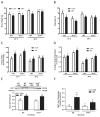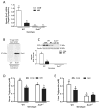The role of suppression of hepatic SCD1 expression in the metabolic effects of dietary methionine restriction
- PMID: 28982014
- PMCID: PMC5788716
- DOI: 10.1139/apnm-2017-0404
The role of suppression of hepatic SCD1 expression in the metabolic effects of dietary methionine restriction
Abstract
Dietary methionine restriction (MR) produces concurrent increases in energy intake and expenditure, but the proportionately larger increase in energy expenditure (EE) effectively limits weight gain and adipose tissue accretion over time. Increased hepatic fibroblast growth factor-21 (FGF21) is essential to MR-dependent increases in EE, but it is unknown whether the downregulation of hepatic stearoyl-coenzyme A desaturase-1 (SCD1) by MR could also be a contributing factor. Global deletion of SCD1 mimics cold exposure in mice housed at 23 °C by compromising the insular properties of the skin. The resulting cold stress increases EE, limits fat deposition, reduces hepatic lipids, and increases insulin sensitivity by activating thermoregulatory thermogenesis. To examine the efficacy of MR in the absence of SCD1 and without cold stress, the biological efficacy of MR in Scd1-/- mice housed near thermoneutrality (28 °C) was evaluated. Compared with wild-type mice on the control diet, Scd1-/- mice were leaner, had higher EE, lower hepatic and serum triglycerides, and lower serum leptin and insulin. Although dietary MR increased adipose tissue UCP1 expression, hepatic Fgf21 messenger RNA, 24 h EE, and reduced serum triglycerides in Scd1-/- mice, it failed to reduce adiposity or produce any further reduction in hepatic triglycerides, serum insulin, or serum leptin. These findings indicate that even when thermal stress is minimized, global deletion of SCD1 mimics and effectively masks many of the metabolic responses to dietary MR. However, the retention of several key effects of dietary MR in this model indicates that SCD1 is not a mediator of the biological effects of the diet.
Keywords: FGF21; acides aminés essentiels; animal models; apport alimentaire; calorimétrie indirecte; dietary intake; essential amino acids; indirect calorimetry; modèles animaux.
Conflict of interest statement
The authors report no conflicts of interest associated with this manuscript.
Figures



Similar articles
-
Hepatic stearoyl CoA desaturase 1 deficiency increases glucose uptake in adipose tissue partially through the PGC-1α-FGF21 axis in mice.J Biol Chem. 2019 Dec 20;294(51):19475-19485. doi: 10.1074/jbc.RA119.009868. Epub 2019 Nov 5. J Biol Chem. 2019. PMID: 31690632 Free PMC article.
-
FGF21 Mediates the Thermogenic and Insulin-Sensitizing Effects of Dietary Methionine Restriction but Not Its Effects on Hepatic Lipid Metabolism.Diabetes. 2017 Apr;66(4):858-867. doi: 10.2337/db16-1212. Epub 2017 Jan 17. Diabetes. 2017. PMID: 28096260 Free PMC article.
-
UCP1 is an essential mediator of the effects of methionine restriction on energy balance but not insulin sensitivity.FASEB J. 2015 Jun;29(6):2603-15. doi: 10.1096/fj.14-270348. Epub 2015 Mar 5. FASEB J. 2015. PMID: 25742717 Free PMC article.
-
The role of stearoyl-CoA desaturase in the control of metabolism.Prostaglandins Leukot Essent Fatty Acids. 2005 Jul;73(1):35-41. doi: 10.1016/j.plefa.2005.04.011. Prostaglandins Leukot Essent Fatty Acids. 2005. PMID: 15941655 Review.
-
Nutritional Regulation of Hepatic FGF21 by Dietary Restriction of Methionine.Front Endocrinol (Lausanne). 2021 Nov 30;12:773975. doi: 10.3389/fendo.2021.773975. eCollection 2021. Front Endocrinol (Lausanne). 2021. PMID: 34917032 Free PMC article. Review.
Cited by
-
The acute transcriptional responses to dietary methionine restriction are triggered by inhibition of ternary complex formation and linked to Erk1/2, mTOR, and ATF4.Sci Rep. 2021 Feb 12;11(1):3765. doi: 10.1038/s41598-021-83380-0. Sci Rep. 2021. PMID: 33580171 Free PMC article.
-
Hepatic stearoyl CoA desaturase 1 deficiency increases glucose uptake in adipose tissue partially through the PGC-1α-FGF21 axis in mice.J Biol Chem. 2019 Dec 20;294(51):19475-19485. doi: 10.1074/jbc.RA119.009868. Epub 2019 Nov 5. J Biol Chem. 2019. PMID: 31690632 Free PMC article.
-
Weight Loss and Concomitant Adipose Autophagy in Methionine-Restricted Obese Mice is Not Dependent on Adiponectin or FGF21.Obesity (Silver Spring). 2020 Jun;28(6):1075-1085. doi: 10.1002/oby.22763. Epub 2020 Apr 29. Obesity (Silver Spring). 2020. PMID: 32348021 Free PMC article.
-
Dietary Methionine Hydroxy Analog Regulates Hepatic Lipid Metabolism via SIRT1/AMPK Signaling Pathways in Largemouth Bass Micropterus salmodies.Biology (Basel). 2025 Feb 21;14(3):227. doi: 10.3390/biology14030227. Biology (Basel). 2025. PMID: 40136484 Free PMC article.
-
MASLD: insights on the role of folate in hepatic lipid metabolism.Front Nutr. 2025 Jul 16;12:1583674. doi: 10.3389/fnut.2025.1583674. eCollection 2025. Front Nutr. 2025. PMID: 40740648 Free PMC article. Review.
References
-
- Binczek E, Jenke B, Holz B, Gunter RH, Thevis M, Stoffel W. Obesity resistance of the stearoyl-CoA desaturase-deficient (scd1−/−) mouse results from disruption of the epidermal lipid barrier and adaptive thermo-regulation. Biol Chem. 2007;388:405–418. - PubMed
MeSH terms
Substances
Grants and funding
LinkOut - more resources
Full Text Sources
Other Literature Sources

